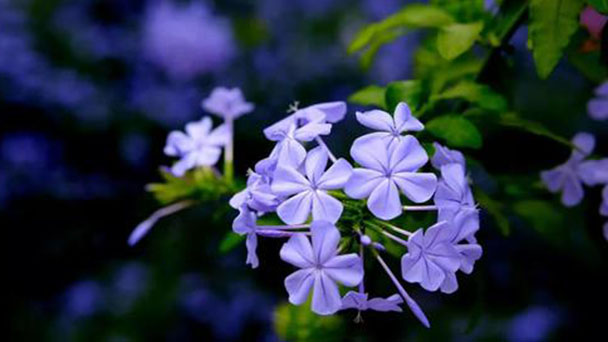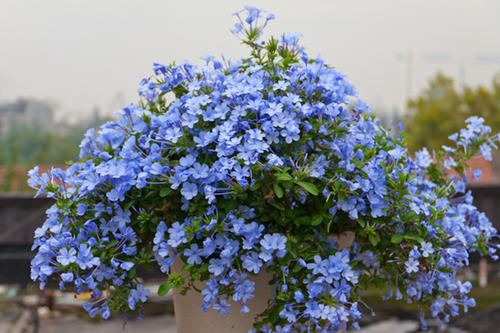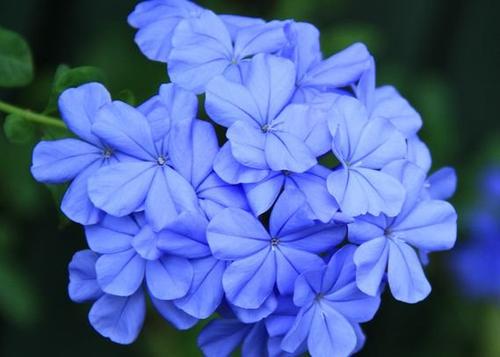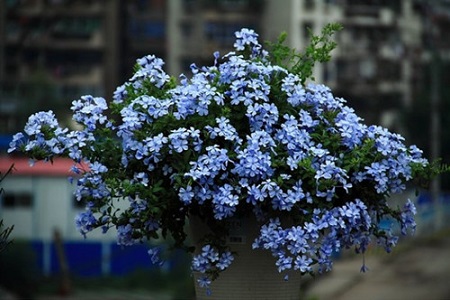Blue plumbago profile
Written by Maggie
Mar 18 2021

Blue plumbago, scientific name Plumbago auriculata, is a perennial evergreen shrub, native to South Africa, and belongs to the genus Blue Plumbago. Ground plant height is 1 ~ 2m, pot 35 ~ 50cm, seedling branches upright, later hanging. It is often cultivated in South China, East China, Southwest China and Beijing. Originally produced in southern South Africa, Blue plumbago has been widely introduced as ornamental plants.
Blue Plumbago picture
Morphological characteristics of Blue Plumbago
Blue Plumbago (Plumbago auriculata) belongs to the Blue Plumbago family. Blue Plumbago is a perennial evergreen shrub, with a plant height of 1 ~ 2m in the ground and a pot of 35 ~ 50cm. The branches are erect when the seedlings are planted and pendant in the later stage. Leaves are simple alternates, leaves thin, entire.
Branches of Blue plumbago (Plumbago auriculata) are angulate, erect when young, tendrilous when grown. Leaves are thin, simple alternate, entire, shortly orbicular or almost oblong-spatulate, apex obtuse with lobes, base cuneate, spikes terminal and axillary, bracts shorter than sepals, calyx with mucinous glandular hair and villous, corolla pale blue, tall saucer-shaped, tube narrow and long, apex 5-lobed.
Upper tip of Blue plumbago (Plumbago auriculata) is vine-like or extremely spreading, ca. 1 m or longer, glabrous except inflorescences, covered with fine calcareous granules.
Inflorescences terminal or axillary, corolla salt plate-shaped, pale Blue or white. Blue Plumbago is warm, heat resistant, light tolerant, slightly shade tolerant, medium drought tolerant. Seeds are 85 per gram.
Blue plumbago (Plumbago auriculata) leaves are thin, ling usually ovate to long ovate, sometimes (undeveloped) elliptic or obovate, long, long (1) 3-6 (7) centimeters, width of 1.5 2 (2.5) (0.5) cm, apex abruptly pointed a little short, pointed, rarely obtuse or emarginate, base cuneate, gradually narrow down into the handle, upper leaf petioles of basal often have small ears of semicircle to oblong.
Inflorescences of Blue plumbago (Plumbago auriculata) are with 18 -- 30 flowers, peduncles short, usually 2 -- 12 mm long, spikes 2 -- 5 (8) cm long, including fruiting, densely covered with grayish-white to yellowish-brown short tomenti on the peduncles and the 1 -- 2 nodes below.
Bracts are 4-10 mm long, 1-2 mm wide, linear-narrow oblate, apex shortly acuminate, bracteoles 2-6 mm long, 1-2 mm wide, narrowly ovate or oblate, apex acute or mucronate.
Blue plumbago (Plumbago auriculata) calyx is 11-13.5 mm long, calyx tube central diameter about 1-1.2 mm, apex with 5 ovate-shaped triangular short lobes, the outer lobes are uniformly puberulent, upper or upper part of the calyx tube and the green part of the lobes bearing stipitate glands; Corolla of Blue plumbago is pale blue to bluish-white, tube 3.2-3.4 cm long, center 0.5-1 mm in diameter, broad corolla eaves, usually 2.5-3.2 cm in diameter, lobes 1.2-1.4 cm long, 1 cm wide, obovate, apex rounded;Stamens slightly protruding beyond larynx, anthers ca. 1.7 mm, blue; Ovary is obpyriform, 5-rowed, ribs broadened and angled at upper part of ovary, style glabrous, stigma concealed.
Blue Plumbago (Plumbago auriculata) leaves are green, flowers and colors are elegant, the hot summer gives people a cool feeling, and can be potted to decorate the bedroom, balcony. Mature Blue plumbago with overhanging branches are more suitable for large container combination potting. The flowering period is from June to September, the capsule is membranous, the fruit is not seen.
Ecological habits of Blue Plumbago
Blue Plumbago (Plumbago auriculata) prefers warm, heat resistant, light tolerant, light tolerant and shade tolerant, and is suitable for warm environments and sandy soil with good drainage. Medium drought tolerance, under the condition of continuous outdoor temperature above 35C in Chongqing, it still grows well, the flower color is bright, and the flowering period lasts long. Blue plumbago likes loose fertile soil, but the viscosity of the larger soil can also grow well. The flower can be seen in early July. The flowering period lasts for a long time, about 2 months.
Blue plumbago, was born in shallow mountain foothills peace on the ground, like warm, not cold resistance, and other temperate regions in north China, as a flower culture exists objectively, growth of optimum temperature 25 ℃, like light, slightly shade-tolerance, should not be in the hot sun exposure, humid environment, dry bad for their growth, not resistant to drought, appropriate is rich in humus, drainage unblocked growing on sandy loam.
Blue Plumbago (Plumbago auriculata) is fond of warm, moist and sunny environments. Blue plumbago is not cold resistant but shade tolerant. It is afraid of strong light exposure. During the growth of the need to often apply rarefied liquid fertilizer, spring and summer growing season once a week. Warm days out of the greenhouse should be placed in a shade or shade shed, according to the plant needs to be reasonably watering. High temperature should shade, timely sprinkle water around the basin soil, spray the new fat film to protect fertilizer and moisture, spray the flower strong tiling in the bud period, can make the bud strong, petal hypertrophy, gorgeous color, rich fragrance of flowers, prolonged flowering period.
Blue Plumbago (Plumbago auriculata) in North China and other temperate regions, as a temperature objective existence of flower cultivation.
Blue Plumbago's distribution area
Blue Plumbago (Plumbago auriculata), originally from South Africa, is now cultivated all over the world. It has been widely introduced as an ornamental plant in various countries. The model specimens are collected from plants cultivated in India.
Blue Plumbago (Plumbago auriculata) is commonly cultivated in South, East and Southwest China and Beijing. It is mainly distributed in Henan Province (Jigong Mountain, Funiu Mountain and Taihang Mountain), north along Taihang Mountain (Shanxi Province) to Beijing, east to Jiangsu Province (Xuzhou), Shanghai and Zhejiang Zhoushan Islands (Qushan Mountain).
Blue Plumbago is grown all over China. In southern China, it is used as open cultivation, while in northern China, it needs to be grown in a greenhouse.
Blue Plumbago growing methods
Blue plumbago (Plumbago auriculata) growing is simpler, the management is more extensive, flower is heat-resistant, resistant to high temperature and high humidity, hot summer Blue plumbago give a person with cool and refreshing feeling, fewer pests and diseases, although its breeding is simpler, but in farming or under a certain of kung fu, so as to offer a better Blue plumbago.
Temperature and light
Blue Plumbago (Plumbago auriculata) likes warmth and is not cold resistant. The suitable temperature for Blue plumbago growth is 25℃, and the maximum tolerance is 35 ° C. Strong light and high temperature favor branching. The minimum temperature in winter should be above 7°C. Blue plumbago likes illumination, also can bear shade, should put its in bright place, accept the direct sunlight of a few hours every day, but do not insulate below scorching sun. It is advisable to allow them to receive a little more sunlight during the winter.
Fertilization
Liquid fertilizer is often applied during the growth of Blue Plumbago and once a week during the spring and summer growing seasons.
Water
Blue Plumbago (Plumbago auriculata) needs a lot of water when it is growing well and keeps the plant's surroundings moist by spraying it with water or placing a pot on a wet stone. Winter to reduce watering children, pot soil can be dry.

Cultivation and potting
Blue Plumbago (Plumbago auriculata) is to be planted in well-drained soil. Change POTS in the spring, if not necessary, remove the plants, prune them properly, and then return them to the original pot with fresh soil.
management
In the process of Blue plumbago growing into seedlings, it is necessary to pick the core for 2-3 times, which can delay the flowering time by about 2 weeks.
Diseases and insect pests
The roots of Blue plumbago (Plumbago auriculata) are vulnerable to root-node nematodes, so attention should be paid to soil disinfection before use, and 80% dibromochloropropane-emulsion diluent can be used to spray the soil surface during the onset of disease. The pest has scale insects, use 25% imine triphosphorus emulsion 1000 times liquid spray control.
The propagation methods of Blue Plumbago
Blue Plumbago (Plumbago auriculata) propagation methods mostly adopt cuttings, plant division method propagation, and also can sow propagation.
Cutting propagation
Blue Plumbago (Plumbago auriculata) cuttings can be done in spring, early summer or late summer. It is carried out every spring in combination with repot pruning. Summer cuttings of biennial robust substantial twigs or semi-mature branches 10-15 cm, inserted in the sand bed, rooting temperature of 20-25℃ is the best, after the insertion of spraying a new high fat film about 20-30 days to root. After 3 weeks can be potted maintenance.Rooting temperature of 20-25℃ is the best. Rooting can be done about 20-30 days after insertion.
Seed propagation
Blue Plumbago (Plumbago auriculata) is easy to plant and you can see the flowers that year. Plant some small days, not only do not love growing bugs, the flowering period is long.
Functions of Blue Plumbago
Ornamental value
Originally produced in southern South Africa, has been widely introduced as ornamental plants.
Blue Plumbago is strong, heat resistant, relatively resistant to high temperature and humidity, less diseases and insect pests, simple management, long ornamental period.Leaf color is emerald green, design and color quietly elegant, hot summer gives a person with cool and refreshing feeling, but potted ornament bedroom, balcony.
Landscape use of Blue Plumbago
Blue Plumbago (Plumbago auriculata) is a mature plant with pendant branches, which is more suitable for large container combination potted plants. Blue plumbago can be used in the environment layout around venues, roads, overpasses and other major roads during the Olympic Games, and can also be planted on the edge of forests or decorated with lawn. Blue plumbago is one of the new excellent flowers to decorate the environment of Beijing during the Olympic Games.

Latest Updated
- Benefits of Bugleweed - 7 Science-backed Health Benefits
- Bugleweed Dangers & Side Effects - Is It Poisonous?
- How to Plant Evergreen Trees - What You Should Know
- When to Plant Evergreens - Grow Guide for Evergreen Trees
- 12 Wonderful Evergreen Shrubs for Your Garden
- 12 Popular Evergreen Plants with Pictures for Beginners
- When And How To Prune A Lilac Bush Like a Pro
- How to Grow & Care for Lilac Vine (Hardenbergia Violacea)
- Japanese Lilac Tree (Syringa Reticulata) Care & Propagation Guide
- Shumard Oak Pros and Cons - What to Know
Popular Articles
- Winter maintenance of Antirrhinum Majus
- How to Grow Terminalia Mantaly Tree
- How to Grow and Care for Crossostephium Chinense
- How to grow Antirrhinum Majus in spring
- Peristeria Elata (Dove Orchid) Profile: Info & Care Guide
- Underwatered Snake Plant (Sansevieria Trifasciata) - Signs And How To Fix
- How to Care for Brazilian Jasmine Plant (Mandevilla Sanderi)
- How to Grow & Care for Graptopetalum Purple Delight in Summer
- Rosa Chinensis (China Rose): Plant Growing & Care Tips
- How to Care for Baby Sun Rose (Aptenia Cordifolia)
